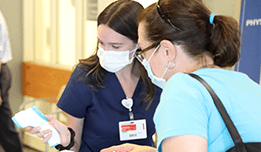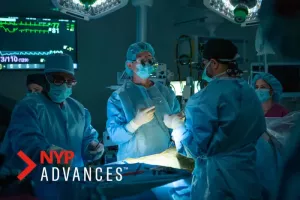Jack Bierwirth's Story
Probably half of Bronxville is now well aware of [NewYork-Presbyterian Westchester], because my wife and I have told them about my experience!
May 15 was a busy day for Jack Bierwirth. The retired Long Island school superintendent left his Bronxville home to go to a nearby school to vote before heading to the railway station to catch a train to Washington, DC. But as he walked from the school to the station, he had a pain in his chest that he says felt like a bad case of indigestion.
“I sat down at this bench in front of the post office, and I said to myself, ‘You really are not feeling right. You ought to go to the hospital instead of getting on this train and going down to Washington, DC,’” Jack recalls. “When I was sitting there, having decided I was going to go to the hospital, this nice friend came up, said, ‘Hey, Jack. How are you?’ And I said, ‘Fine.’ And then I said, ‘No. Actually, I'm not fine. I've decided to go to the hospital.’ And he said, ‘Okay. I'll give you a hand.’”
A passerby offered to take the men to the nearby NewYork-Presbyterian Westchester. At the hospital, Jack was quickly assessed by medical staff. To confirm whether or not Jack had had a heart attack, the emergency department doctors rushed him to the catheterization laboratory. The cath lab, which opened in 2015, is run by a team of experienced and well-respected cardiologists, interventional cardiologists, and electrophysiologists from ColumbiaDoctors, the faculty practice of Columbia University Irving Medical Center. With the cath lab, doctors have been able to dramatically reduce the time heart attack patients like Jack wait to receive vitally important care.
Dr. Craig Hjemdahl-Monsen, an interventional cardiologist at NewYork-Presbyterian Westchester, performed an angiogram, which showed Jack had a blockage in his coronary arteries. Coronary arteries supply the heart with blood. Fatty deposits, known as plaque, can build up in the arteries, causing a blockage. When the plaque breaks away, it can form blood clots that cause heart attacks.
To treat the heart attack Dr. Hjemdahl-Monsen placed a stent — a tiny tube — into Jack’s heart to keep his arteries open. Jack remained in the hospital for several days following treatment and was then referred to cardiac rehabilitation. At NewYork-Presbyterian Westchester, anyone who has had a heart attack, bypass surgery, angioplasty or stents, heart transplantation, or heart valve repair or replacement is eligible for the cardiac rehabilitation program. One of the only programs of its kind in southern Westchester County, the Cardiopulmonary Rehabilitation program allows patients to exercise and regain their strength in a medically supervised and safe environment.
“I did know that [NewYork-Presbyterian Westchester] had done lots of things, but I was not aware of these services,” Jack says. “Probably half of Bronxville is now well aware of it, because my wife and I have told them about my experience!”
Since his heart attack, Jack is returning back to his normal life — and preparing to finally make his trip to Washington, DC. He continues his cardiac care with Dr. Mitchell H. Fishbach, a cardiologist at NewYork-Presbyterian Westchester.
“I was very lucky. I texted a couple of people to tell them where I was and what was happening, and they said that they were sure God had steered me from walking from the train station to going to the hospital,” he says. “God forbid I'd had a heart attack on the middle of Amtrak. It's one of the few sensible things I think I've done in my life. Just steering to the hospital instead of getting on the train.”



